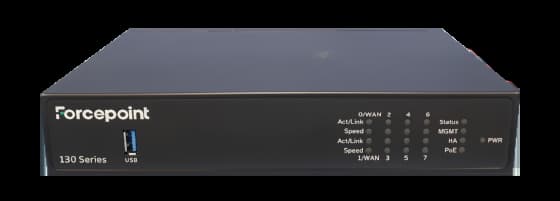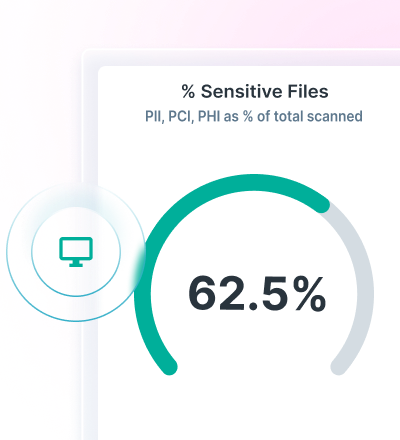
1.2万社以上のお客様に利用されています










































オフィス、支店、遠隔地のネットワークアクセスを拡張し、安全に保護します。
広域ネットワークでセキュリティを実現。Forcepoint Secure SD-WANは、世界中のすべての場所で優れた接続性を維持しながら、Zero Trustのセキュリティコントロールで高度な脅威からネットワークを保護します。
Forcepoint Secure SD-WANを選ぶ理由
一元化管理:クラウドから支店、オフィス、遠隔地を有効にします。ポリシーを一度設定したら、Secure Management Console(SMC)でゼロタッチ配備を使用します。
アプリケーションパフォーマンスを向上:マルチリンク接続、動的なトラフィックステアリングやアプリケーション健全性の監視などの機能を適用して、遅延やジッタを低減することができます。
高度な脅威から保護:多層検査、侵入防止、DNSシンクホールなどを使用してリスクを検出して防止しながら、ZTNAアプリケーションコネクタを介してオンサイトまたはリモートアプリケーションへのアクセスを保護します。
運用コストを削減:ローカルISPブロードバンドとプライベートMPLSをリアルタイムで組み合わせることでネットワークコストを削減し、信頼性を高めます。
データシート
アプライアンスモデルの比較


Global Network
20+
Countries
45+
Cluster Nodes
Clustering In a Way No One Else Can Do
Christian Keller, CISO at Huber + Suhner, lists reliability, clustering, and ability to navigate global compliance requirements among the top benefits of Forcepoint NGFW.
Forcepoint Secure SD-WANモデルについて詳しく見る

350シリーズ
遠隔地や支社に最適(デスクトップ設計)。
最大13インターフェース
ファイアウォールスループット40Gbps
IPS NGFWスループット2Gbps(N352)または4.1Gbps(N355)

130シリーズ
Ideal for remote offices, branches and stores.
最大8インターフェース
ファイアウォールスループット8 Gbps
IPS NGFWスループット1,600 Mbps
クラウドイメージ:
- 統合されたForcepoint NGFWソフトウェア
- Amazon Web Services (AWS)
- Microsoft Azureソリューション
- クラウドを出入りする通信と、SDNのトラフィックの両方を保護
仮想アプライアンス:
- 統合されたForcepoint NGFWソフトウェア
- KVM、VMware ESXiおよびNSXで使用可能
- 最大64CPUに拡張可能
- ネットワークマイクロセグメンテーションを自動化
- 物理ファイアウォールでクラスタ化可能


Secure SD-WANの購入ガイド
初めて購入する方やアップグレードを検討している方向けに、当社のガイドにはSecure SD-WANソリューションを評価するための重要な基準が記載されています。考慮すべき5つの重要なポイントをご紹介します。
SD-WANが選ばれる理由
SD-WANが選ばれる理由
"Our costs - both for the project and maintenance - are going down because we don't need resources locally, we have centralized everything. If we want new service on a train, we define the policy then give the hardware to the operator, who installs it."
VR Group
Frequently Asked Questions
What is managed SD-WAN?
A managed SD-WAN is a service where a provider handles the deployment, configuration, monitoring and optimisation of your WAN. Meanwhile, a cloud-managed SD-WAN adds centralised control via the cloud, making it easier to apply consistent policies, improve performance and maintain security across distributed networks without internal resource strain. Learn more about this product through our comprehensive managed SD-WAN solutions guide.
What are the benefits of SD-WAN?
Benefits of Forcepoint Secure SD-WAN include the following:
Centralized management
Improved application performance
Protection against advanced threats
Reduced operating costs
How much does SD-WAN cost?
SD-WAN costs are determined by factors, including the type of deployment, the size of the network, the number of locations to connect, the type and amount of data transiting the network and any existing infrastructure that may be leveraged when deploying an SD-WAN solution.
What is SD-WAN security?
SD-WAN security helps organizations enable effortless connection to cloud resources while protecting users, data and IT environments from attack.
What is an SD-WAN solution?
Ad SD-WAN solution applies software-defined networking principles to the wide area network.
What is an SD-WAN provider?
SD-WAN providers enable organizations to deploy SD-WAN technology.
What is an SD-WAN appliance?
SD-WAN appliances are physical or virtual controllers located on-premises or in the cloud that connect an organization’s users to applications, services and workloads.
How do SD-WAN appliances work?
SD-WAN appliances and products are designed to overcome the challenges of ensuring fast and secure connectivity for branch locations and hybrid workforces. The traditional wide area network uses a hub-and-spoke model that requires all traffic to flow through a central data center. For organizations with a highly distributed workforce, this model adds unacceptable levels of latency that negatively affect user experiences and productivity. Additionally, legacy WANs are built with costly Multiprotocol Label Switching (MPLS) connections that are time-consuming to manage and deploy, preventing organizations from scaling easily and cost-efficiently. SD-WAN overcomes these issues by creating a virtual overlay for the network that abstracts network connections and enables the use of additional, low-cost transport services that add redundancy and flexibility.
What is Multiprotocol Label Switching (MPLS)?
Multiprotocol Label Switching (MPLS) is data forwarding technology that increases the speed and controls the flow of network traffic.
What is SD-WAN vs MPLS?
SD-WAN is a networking technology that uses software to make wide area networks more intelligent and flexible by connecting sites directly to the internet over commodity broadband links. Configurations and access policies are centrally managed and easily applied across all sites, removing the need to manual administer each WAN device individually. MPLS is data forwarding technology for network traffic that directs data through a path via labels instead of requiring complex lookups in a routing table at every stop. Traditional networking technology, MPLS, has seen competition from SD-WAN solutions to meet today's high demands and expanding needs for networked business-critical systems.
















